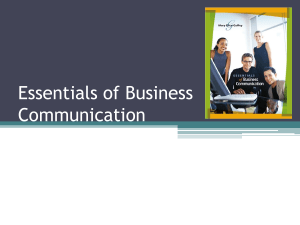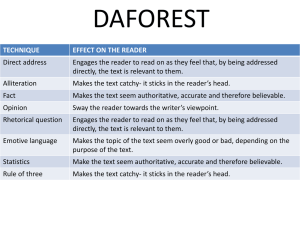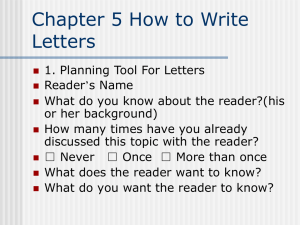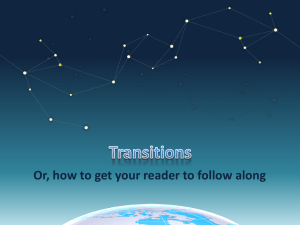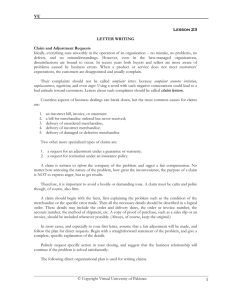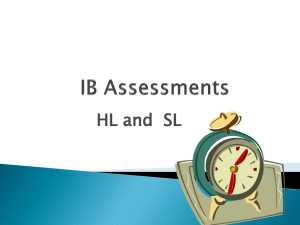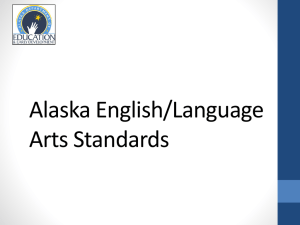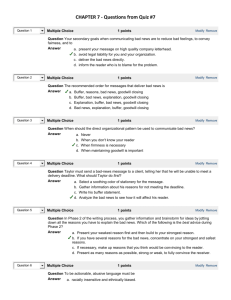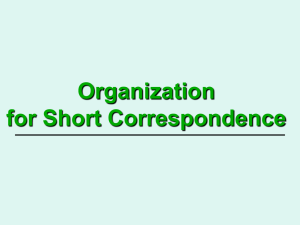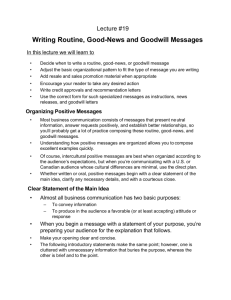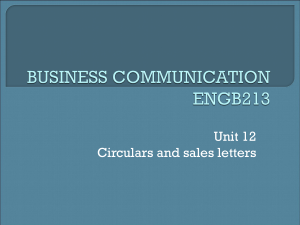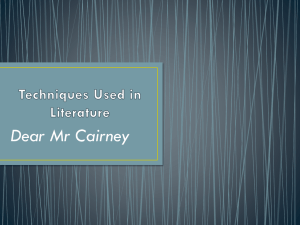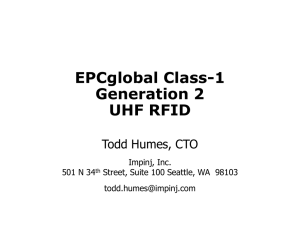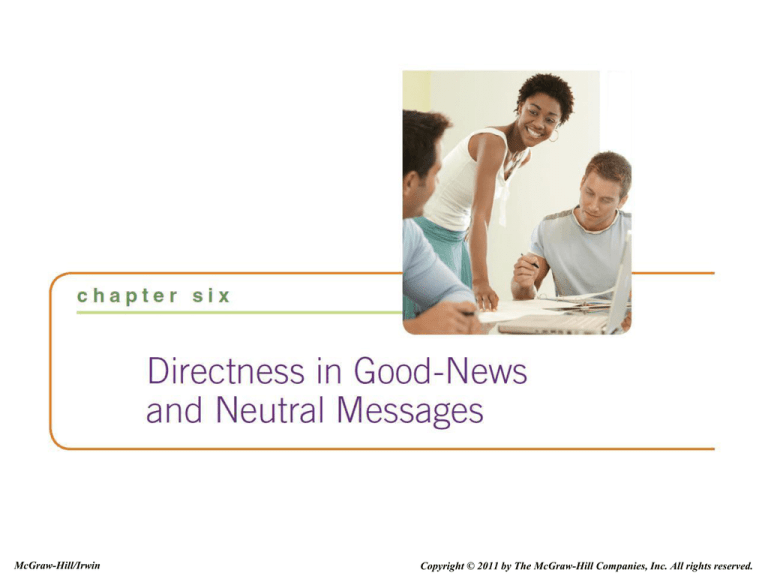
McGraw-Hill/Irwin
Copyright © 2011 by The McGraw-Hill Companies, Inc. All rights reserved.
Overview
• Preliminary Assessment
• A General Direct Plan
• Applications of the General Plan
– Routine inquiries
– Favorable responses
– Adjustment grants
– Order acknowledgments
– Operational messages
6-2
Preliminary Assessment
• Determine the reader’s probable reaction—
positive, neutral, negative.
– If the reader’s reaction is likely positive or neutral, use
a direct approach.
•
•
•
•
Asking for something your reader is likely to grant
Complying with the reader’s request
Giving good news
Acknowledging an order
– If the reader’s reaction is likely negative, use an
indirect approach.
• Asking for something your reader will not grant
• Refusing a request
6-3
Direct Plan: Routine Inquiry
• Begin directly with the objective.
– Ask a specific question, or
– Make a general request for the information.
• Include any necessary explanation.
• Structure your questions.
– Number them.
– Use textual formatting (e.g., bold, italics).
• End with goodwill words specific to the
message.
6-4
Routine Inquiry: Bad Example
Dear Mr. Crifasi:
As you will recall, you recently returned merchandise to us. We at Hobsons
sincerely hope that this transaction was satisfactory. In fact, we are in the
process of making changes which will ensure that such transactions are
favorably handled. Thus, we would like the answers for some questions about
your experiences returning merchandise to us.
We’d like to know whether you were served promptly and courteously and
whether the adjustment was satisfactory and in accordance with your wishes.
Also, we’d like to know whether the salesperson offered assistance to you in
selecting other merchandise.
Just go to our website and click on the link for the customer satisfaction
survey or send your response through the mail. Thanking you in advance for
your cooperation, I remain,
Sincerely,
6-5
Direct Approach: Favorable Response
• Begin with the answer or state you are complying
with the request.
• Identify the message being answered
– incidentally in the beginning or
– in a subject line.
•
•
•
•
Provide additional relevant information.
Deemphasize any negative information.
Consider including extras.
Provide a closing that builds goodwill and is
specific to the message.
6-6
Favorable Response: Bad Example
Dear Sir:
We are in receipt of your favor of April 12 in which you request that we
furnish you a copy of our current Baton Rouge directory with certain
notations and recommendations. In reply I wish to assure you that we
are very much interested in your proposed online directory of
Louisiana manufacturers and believe it is a project which should be
supported by Louisiana industry in every possible way.
In order to ascertain whether or not a particular manufacturer listed in
our directory is a producer or is only the sales agent for goods
manufactured outside the State, it will be obviously necessary for us
to put a responsible and capable clerk on
6-7
Favorable Response: Bad Example
the assignment to contact by telephone each manufacturer listed and to
request information direct as to his classification and the nature of his
operations. We are quite willing to do this, despite our own manpower
shortage, in order to further your project, and in fact we have already
selected the man and assigned his duties to him. He will start to work
at an early date, and we will notify you in due course as to his progress.
Assuming you of our continued interest, and trusting that you will not
hesitate to call on us in the future at any time we may be of service to
you in any way, we are
Sincerely,
6-8
Adjustment Grants
• Begin the good news directly .
• Incidentally identify the message you are
answering.
• Avoid or deemphasize negatives that recall
the situation being corrected.
• Regain lost confidence through explanation or
corrective action.
• End with friendly, positive words.
6-9
Adjustment Grant: Bad Example
Ms. McPhee:
We are very sorry that our product failed you. Normally, any item of clothing is
cleaned safely, but in your case this did not happen.
We thoroughly examined the suit you returned to us. Our investigation showed
that the likely cause of the fading some kind of chemical being spilled on the suit,
but we can’t be sure. The problem, though, was definitely on our end and no
fault of yours. We are definitely taking steps to ensure that this does not happen
in the future.
We did credit your account for $321.40 and want you to know how sorry we are
that this happened. We truly value your business and hope that you want to do
business with us in the near future.
Albert T. Hamm, Manager
Consumer Relations
6-10
Order Acknowledgments
•
•
•
•
Give the status of order.
Build goodwill.
Include a “thank you.”
If there is a problem (vague order, back order)
– Report directly regarding delays, or
– Use a tactful approach to get needed information on
vague orders or to report back orders.
• Close with friendly words adapted to the
message.
6-11
Order Acknowledgment: Bad Example
Mr. Cotton:
As you know, many times shipment delays are unavoidable, no matter how hard
we try to be timely. I’m afraid this is one of those times.
You ordered a very popular item, and we are just not able to ship them as quickly
as you require, though we are working overtime to get them to you as quickly as
possible. You should have already received the assorted pipe you ordered. The
rest of the order should get to you by the August 12th—only a two week delay.
If this causes you problems, please feel free to contact me. I look forward to
serving you.
Krystal Benko
Office Manager
6-12
Other Thank-You Messages
• Be brief and direct.
• Use a salutation appropriate for your
relationship with the reader.
• Begin with the “thank you.”
• Follow with a personalized comment about
the reader.
• End with a friendly, goodwill close relevant to
the topic of the message.
6-13
Thank-You Message: Good Example
Dear Mr. Morris:
Thank you for meeting with me last Thursday and for providing me with
information for my report on green practices in local companies.
Your insights, description of Morris Communication’s green practices, and
materials you provided all helped make my report a success.
I wish you and your company well as you implement your electronics
recycling program next fall.
Sincerely,
Kelly Williams
6-14
Operational Messages
• The internal communications needed in a
company’s work
– Casual
• Quick responses to immediate work needs
• Conversational but very direct, frank
– Moderately formal
• More carefully constructed direct messages
• Conversational, straightforward but courteous
– Highly formal
• Messages about policies, procedures, or directives
• Formally written by superiors to subordinates
6-15





